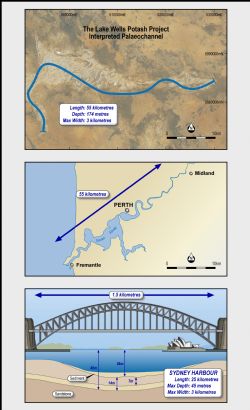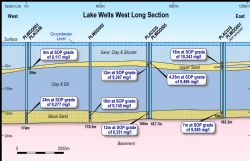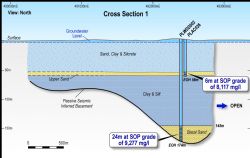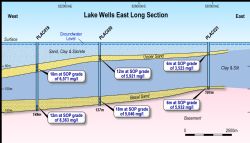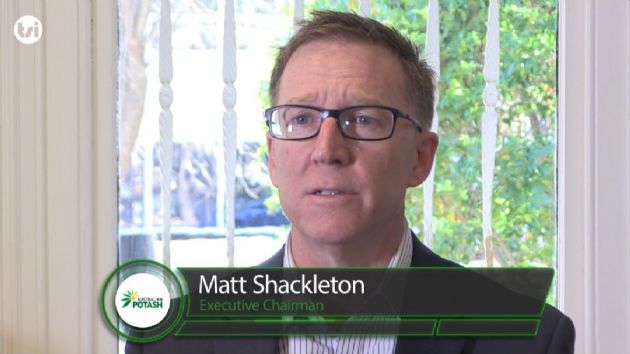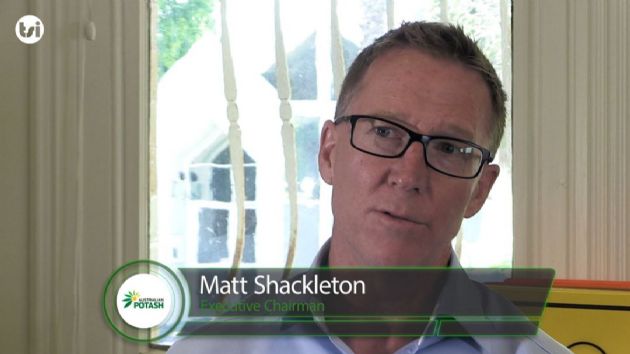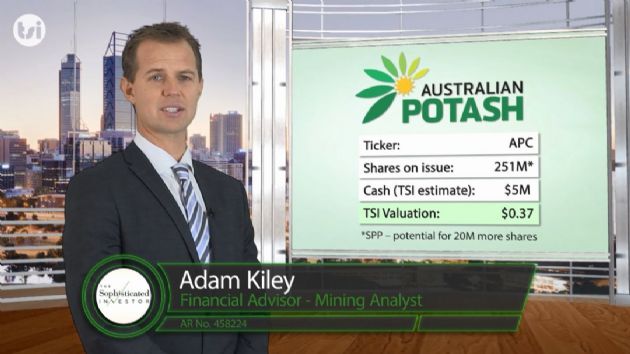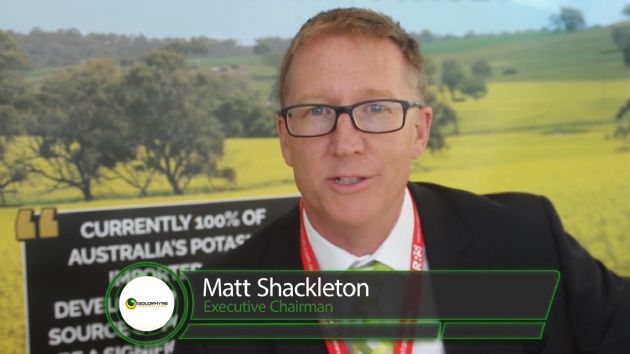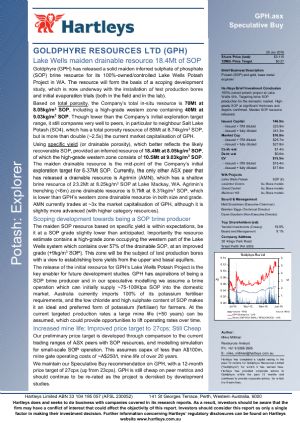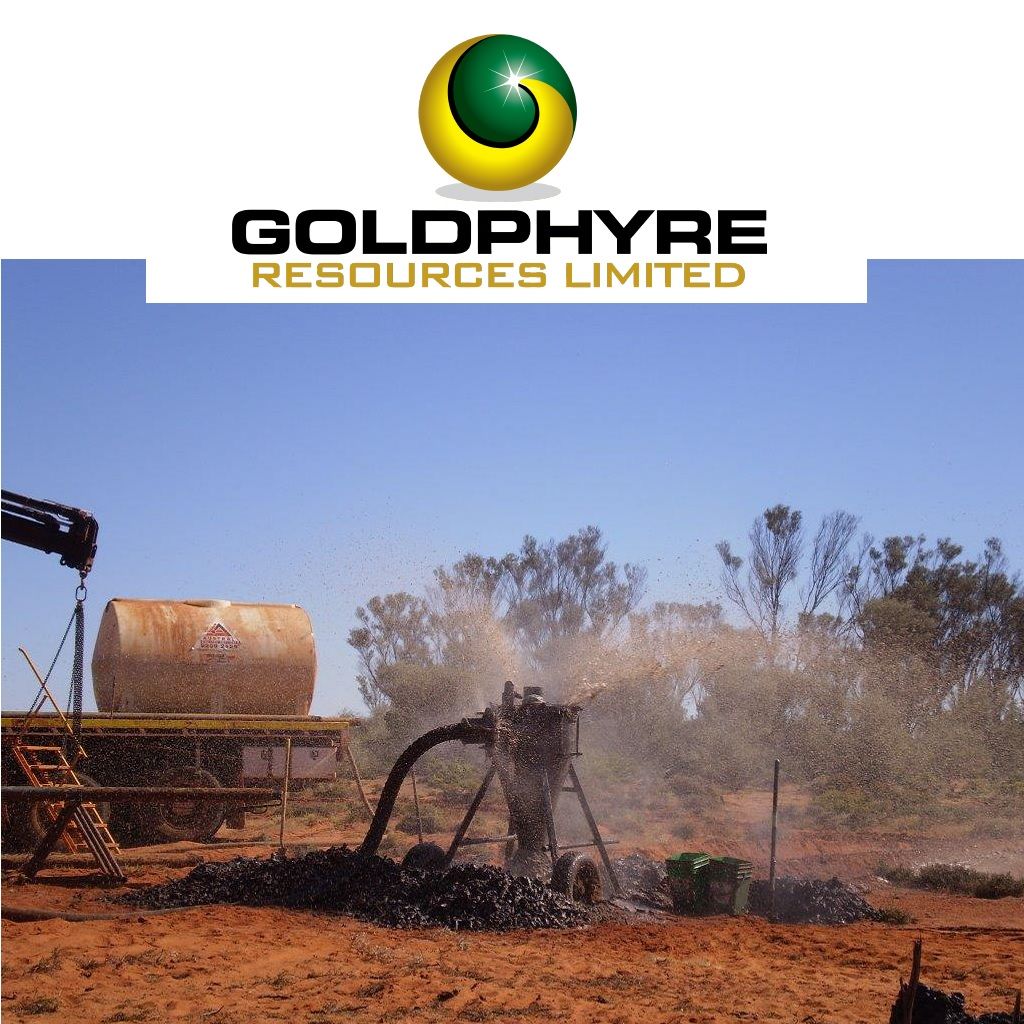
Final Assays Highlight Quality and Scale of Lake Wells Potash SOP Project
Perth, May 31, 2016 AEST (ABN Newswire) - Goldphyre Resources ( ASX:GPH) is pleased to announce strong final assays from the key basal and upper sands at its Lake Wells Potash Project, 500km north-east of Kalgoorlie.
ASX:GPH) is pleased to announce strong final assays from the key basal and upper sands at its Lake Wells Potash Project, 500km north-east of Kalgoorlie.
Key Points:
- Final assays from the Lake Wells Potash Project reveal continued strong grades and wide intersections of the premium-priced sulphate of potash (SOP)
- Further intersections of both upper and lower basal sands reinforce potential for potash-bearing aquifers in both sand layers
- Test production bores to be installed into the upper and lower aquifers at two sites: test pumping planned for Q3
- 2 further holes were drilled slightly north of the interpreted palaeochannel sand trend confirming very high SOP grades
The assays stem from the seven remaining air-core holes from the May drilling program (Figure 2, see link below). The Company is on track to release the Lake Wells Potash Project's Maiden JORC Mineral Resource estimate in June 2016.
The average SOP grades of assays from the March and May drilling program are within the range estimated in the Lake Wells Potash Project Exploration Target.
The potential quantity and grade of the Exploration Target is conceptual in nature. There has not yet been sufficient exploration to estimate a Mineral Resource and it is uncertain if further exploration will result in the estimation of a Mineral Resource.
Goldphyre Executive Chairman Matt Shackleton said the latest assays further strengthened the Company's confidence in the project's ability to be a significant producer of sulphate of potash for the Australian market.
"The results are particularly strong as we move west. We have more than 55km of palaeochannel, which as Figure 1 below demonstrates, leads to the significant brine volume as detailed in our exploration target" Mr Shackleton said.
"With depths to basement of up to 174 metres, significant widths of sand layers in the palaeochannel sediments, high grades of SOP from surface to basement and our existing logistical advantage, we are firmly of the view that the Lake Wells Potash Project will deliver value for Goldphyre shareholders.
"We are now planning the installation of test production bores in the September 2016 quarter, which will provide further key information about the economic potential of Lake Wells."
Technical discussion
Following the successful mud-rotary program in March, where thick intersections of the high-yielding basal sand layer were recorded, further air-core drilling has been undertaken. The main aim of the air-core program was to assess the brine chemistry of the basal sand layer.
The basal sand intersections are considered highly significant because it is from this layer of the palaeochannel sediments that Goldphyre is proposing to abstract the largest volumes of the high-grade potash brines confirmed in previous drilling.
In addition to confirming the significant and consistent potash grades at depth, this recent air-core campaign again intersected significant widths of the upper sand unit, previously not considered in the Exploration Target the Company published in March.
This upper aquifer has returned consistent brine concentrations with the potential to improve the yield possible from the palaeochannel system.
The sand units have been interpreted to comprise:
i. upper sand - typically medium to coarse-grained (0.5mm - 2mm) quartz sand with sub-angular to sub-rounded grains, and;
ii. basal sand - typically medium to coarse-grained (0.5mm - 2mm) quartz sand +/- minor well rounded quartz and lithic pebbles at the base.
Other potential aquifer units encountered in recent drilling include near surface coarsegrained evaporite and sand/silt, overlying friable and fragmental silcrete +/- laterite. Strong brine flows were commonly recorded in these lithology types.
Several drill-holes also returned a minor but persistent sand component to the clay/silt dominated inter-beds lying between the upper and basal sand units that exhibited strong brine flows.
The Exploration Target at the Lake Wells Potash Project is 6 - 37 million tonnes of contained sulphate of potash at a grade range of 8,900mg/l - 13,900mg/l. This estimate is based on the specific yield of the sand aquifer units. Goldphyre considers this the more relevant calculation because it represents the readily recoverable amount of potash. This in turn is the key figure used to calculate potential production rates and economic returns.
Goldphyre has also estimated a total in-situ brine of 79 - 123 million tonnes of contained sulphate of potash at a grade range of 11,400mg/l - 13,900mg/l, based on the porosity of the entire regolith profile. This calculation is disclosed for industry comparison purposes only and, while a percentage of brine is likely to drain from the non-sand regolith materials, does not represent the amount of potash the Company believes it can abstract at the Project.
Figures 3 - 5 (see link below) depict the lithology and sand aquifer units encountered at the various drill sites reported here. The palaeochannel clays typically have a specific yield of 2% - 3%, meaning that only a small fraction of the brines held within them can be extracted. In contrast, the upper and basal sands typically have a specific yield of 23% - 28%, meaning that nearly ten times the brine held in the sand layers can be extracted compared to the clay layers. The higher permeability and specific yield material present in the palaeochannel, the more brine can be recovered.
The Lake Wells Potash Project
A drilling program conducted at Lake Wells in July 2015 identified high-grade potash mineralisation both beneath the lake and the low dune areas surrounding the lake. That drilling program generated wide intercepts of high-grade potash to depths of 135m (down-hole), which was the depth capacity of the drill rig used.
Passive seismic survey programs have been conducted at the Project. This data permits the clear targeting of drill holes into the deepest parts of the palaeochannel.
Unconsolidated sand-grit material often resides in the basal section of these palaeovalleys and the sand/grit material has a high permeability, which facilitates drainage of the overlying hydrogeological units.
Goldphyre has completed successfully mud rotary/diamond and air-core drilling programs aimed at understanding the basal sand layer and to confirm deep brine chemistry. The Company plans to release a Maiden JORC Resource Estimate in June 2016.
To view tables and figures, please visit:
http://abnnewswire.net/lnk/96Q87U49
About Australian Potash Ltd
Australian Potash Limited (ASX:APC) is an ASX-listed Sulphate of Potash (SOP) developer. The Company holds a 100% interest in the Lake Wells Potash Project located approximately 500kms northeast of Kalgoorlie, in Western Australia's Eastern Goldfields.
Following the release of a Scoping Study in 2017, APC has been conducting a Definitive Feasibility Study (DFS) into the development of the Lake Wells Potash Project. The Company is aiming to release the findings of the DFS in H2 2019.
The Lake Wells Potash Project is a palaeochannel brine hosted sulphate of potash project. Palaeochannel bore fields supply large volumes of brine to many existing mining operations throughout Western Australia, and this technique is a well understood and proven method for extracting brine. APC will use this technically low-risk and commonly used brine extraction model to further develop a bore-field into the palaeochannel hosting the Lake Wells SOP resource.
A Scoping Study on the Lake Wells Potash Project was completed and released on 23 March 2017. The Scoping Study exceeded expectations and confirmed that the Project's economic and technical aspects are all exceptionally strong, and highlights APC's potential to become a significant long-life, low capital and high margin sulphate of potash (SOP) producer.
| ||
|




